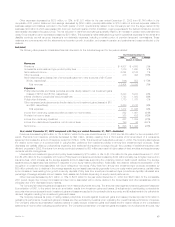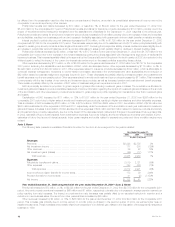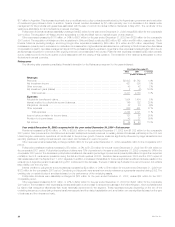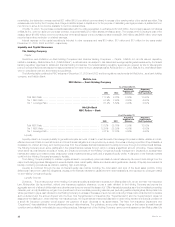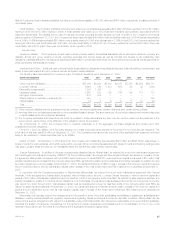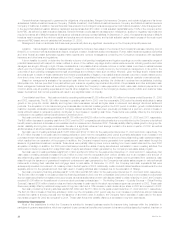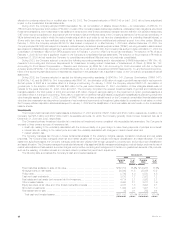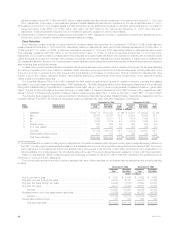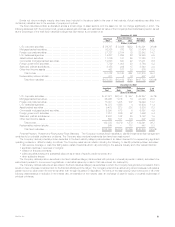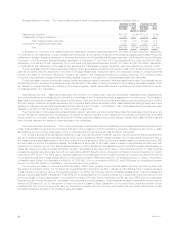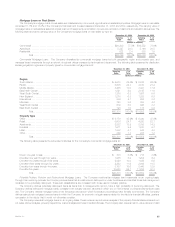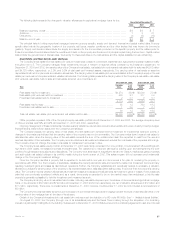MetLife 2003 Annual Report Download - page 30
Download and view the complete annual report
Please find page 30 of the 2003 MetLife annual report below. You can navigate through the pages in the report by either clicking on the pages listed below, or by using the keyword search tool below to find specific information within the annual report.failed life insurers. These associations levy assessments, up to prescribed limits, on all member insurers in a particular state on the basis of the
proportionate share of the premiums written by member insurers in the lines of business in which the impaired, insolvent or failed insurer engaged. Some
states permit member insurers to recover assessments paid through full or partial premium tax offsets. Assessments levied against the Company from
January 1, 2001 through December 31, 2003 aggregated $7 million. The Company maintained a liability of $70 million at December 31, 2003 for future
assessments in respect of currently impaired, insolvent or failed insurers.
In the past five years, none of the aggregate assessments levied against MetLife’s insurance subsidiaries has been material. The Company has
established liabilities for guaranty fund assessments that it considers adequate for assessments with respect to insurers that are currently subject to
insolvency proceedings.
Effects of Inflation
The Company does not believe that inflation has had a material effect on its consolidated results of operations, except insofar as inflation may affect
interest rates.
Application of Recent Accounting Standards
Effective December 31, 2003, the Company adopted Emerging Issues Task Force (‘‘EITF’’) Issue No. 03-1, The Meaning of Other-Than-Temporary
Impairment and Its Application to Certain Investments, (‘‘EITF 03-1’’). EITF 03-1 provides guidance on the disclosure requirements for other-than-
temporary impairments of debt and marketable equity investments that are accounted for under Statement of Financial Accounting Standards
(‘‘SFAS’’) No. 115, Accounting for Certain Investments in Debt and Equity Securities. The adoption of EITF 03-1 requires the Company to include certain
quantitative and qualitative disclosures for debt and marketable equity securities classified as available-for-sale or held-to-maturity under SFAS 115 that
are impaired at the balance sheet date but for which an other-than-temporary impairment has not been recognized. The initial adoption of EITF 03-1,
which only required additional disclosures, did not have a material impact on the Company’s consolidated financial statements.
In December, 2003, the Financial Accounting Standards Board (‘‘FASB’’) revised SFAS No. 132, Employers’ Disclosures about Pensions and Other
Postretirement Benefits — an Amendment of FASB Statements No. 87, 88 and 106 (‘‘SFAS 132(r)’’). SFAS 132(r) retains most of the disclosure
requirements of SFAS 132 and requires additional disclosure about assets, obligations, cash flows and net periodic benefit cost of defined benefit
pension plans and other defined postretirement plans. SFAS 132(r) is primarily effective for fiscal years ending after December 15, 2003; however, certain
disclosures about foreign plans and estimated future benefit payments are effective for fiscal years ending after June 15, 2004. The Company’s adoption
of SFAS 132(r) on December 31, 2003 did not have a significant impact on its consolidated financial statements since it only revises disclosure
requirements. In January 2004, the FASB issued FASB Staff Position (‘‘FSP’’) No. 106-1, Accounting and Disclosure Requirements Related to the
Medicare Prescription Drug, Improvement and Modernization Act of 2003 (‘‘FSP 106-1’’), which permits a sponsor of a postretirement health care plan
that provides a prescription drug benefit to make a one-time election to defer accounting for the effects of the new legislation. The Company has elected
to defer the accounting until further guidance is issued by the FASB. The measurements of the Company’s postretirement accumulated benefit plan
obligation and net periodic benefit cost do not reflect the effects of the new legislation. The guidance, when issued, could require the Company to
change previously reported information.
In July 2003, the Accounting Standards Executive Committee of the American Institute of Certified Public Accountants issued Statement of Position
03-1, Accounting and Reporting by Insurance Enterprises for Certain Nontraditional Long-Duration Contracts and for Separate Accounts (‘‘SOP 03-1’’).
SOP 03-1 provides guidance on (i) the classification and valuation of long-duration contract liabilities, (ii) the accounting for sales inducements, and
(iii) separate account presentation and valuation. SOP 03-1 is effective for fiscal years beginning after December 15, 2003. As of January 1, 2004, the
Company increased future policyholder benefits for various guaranteed minimum death and income benefits net of DAC and unearned revenue liability
offsets under certain variable annuity and universal life contracts of approximately $40 million, net of income tax, which will be reported as a cumulative
effect of a change in accounting. Industry standards and practices continue to evolve relating to the valuation of liabilities relating to these types of
benefits, which may result in further adjustments to the Company’s measurement of liabilities associated with such benefits in subsequent accounting
periods. Effective with the adoption of SOP 03-1, costs associated with enhanced or bonus crediting rates to contractholders will be deferred and
amortized over the life of the related contract using assumptions consistent with the amortization of DAC. Prior to adoption of SOP 03-1, the costs
associated with these sales inducements have been deferred and amortized over the contingent sales inducement period. This provision of SOP 03-1
will be applied prospectively to contracts. Effective January 1, 2004, the Company reclassified $115 million of ownership in its own separate accounts
from other assets to fixed maturities available-for-sale and equity securities. This reclassification will have no effect on net income or other comprehensive
income. In accordance with SOP 03-1’s revised definition of a separate account, effective January 1, 2004, the Company also reclassified $1,678 million
of separate account assets to general account investments and $1,678 million of separate account liabilities to future policy benefits and policyholder
account balances. The net cumulative effect of this reclassification was insignificant.
In May 2003, the FASB issued SFAS No. 150, Accounting for Certain Financial Instruments with Characteristics of Both Liabilities and Equity
(‘‘SFAS 150’’). SFAS 150 clarifies the accounting for certain financial instruments with characteristics of both liabilities and equity and requires that those
instruments be classified as a liability or, in certain circumstances, an asset. SFAS 150 is effective for financial instruments entered into or modified after
May 31, 2003 and otherwise is effective at the beginning of the first interim period beginning after June 15, 2003. The adoption of SFAS 150, as of
July 1, 2003, required the Company to reclassify $277 million of company-obligated mandatorily redeemable securities of subsidiary trusts from
mezzanine equity to liabilities.
In April 2003, the FASB cleared Statement 133 Implementation Issue No. B36, Embedded Derivatives: Modified Coinsurance Arrangements and
Debt Instruments That Incorporate Credit Risk Exposures That Are Unrelated or Only Partially Related to the Creditworthiness of the Obligor under Those
Instruments (‘‘Issue B36’’). Issue B36 concluded that (i) a company’s funds withheld payable and/or receivable under certain reinsurance arrangements,
and (ii) a debt instrument that incorporates credit risk exposures that are unrelated or only partially related to the creditworthiness of the obligor include an
embedded derivative feature that is not clearly and closely related to the host contract. Therefore, the embedded derivative feature must be measured at
fair value on the balance sheet and changes in fair value reported in income. Issue B36 became effective on October 1, 2003 and required the Company
to increase policyholder account balances by $40 million, to decrease other invested assets by $1 million and to increase DAC by $2 million. These
amounts, net of income tax of $13 million, were recorded as a cumulative effect of a change in accounting. As a result of the adoption of Issue B36, the
Company recognized investment gains of $9 million, net of income tax, for the three month period ended December 31, 2003.
In April 2003, the FASB issued SFAS No. 149, Amendment of Statement 133 on Derivative Instruments and Hedging Activities (‘‘SFAS 149’’).
SFAS 149 amends and clarifies the accounting and reporting for derivative instruments, including certain derivative instruments embedded in other
contracts, and for hedging activities. Except for certain implementation guidance that is incorporated in SFAS 149 and already effective, SFAS 149 is
MetLife, Inc. 27


